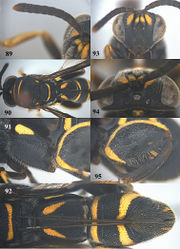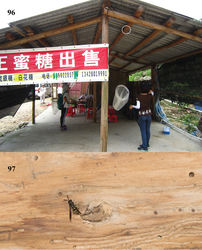Leucospis histrio
| Notice: | This page is derived from the original publication listed below, whose author(s) should always be credited. Further contributors may edit and improve the content of this page and, consequently, need to be credited as well (see page history). Any assessment of factual correctness requires a careful review of the original article as well as of subsequent contributions.
If you are uncertain whether your planned contribution is correct or not, we suggest that you use the associated discussion page instead of editing the page directly. This page should be cited as follows (rationale):
Citation formats to copy and paste
BibTeX: @article{Ye2017ZooKeys, RIS/ Endnote: TY - JOUR Wikipedia/ Citizendium: <ref name="Ye2017ZooKeys">{{Citation See also the citation download page at the journal. |
Ordo: Hymenoptera
Familia: Leucospidae
Genus: Leucospis
Name
Leucospis histrio Maindron, 1878 – Wikispecies link – Pensoft Profile
- Leucospis histrio Maindron, 1878: cxxx; Bouček 1974a[1]: 164; Bouček and Narendran 1981[2]: 7; Narendran 1986[3]: 44.
- Leucospis ornatifrons Weld, 1922: 22. Syn. by Bouček (1974a)[1].
Type material
Holotype of Leucospis ornatifrons, ♀ (USNM), “[PHILIPPINES], Manila”, “Type No. 24386, U.S.N.M.”, USNMENT01197921. Additional material. 1♀, CHINA, Guangdong, Fogang, Guangyinshan Provincial Natural Reserve, 15–16.IX.2007, Zai-fu Xu, No. 2016000036 (SCAU); 1♀, CHINA, Guangdong, Xiangtoushan National Nature Reserve, 4.VI.2016, Qi Yue, No. 2016000137 (SCAU); 1♀, CHINA, Hainan, Bawangling National Nature Reserve, 21–22.X.2007, Jie-min Yao, No. 2016000041 (SCAU).
Diagnosis
Body mainly black with yellow pattern (Fig. 88), antennal scape partly yellow ventrally (Figs 89, 93), frontovertex with two yellow spots (Figs 89, 93), wings brownish, hind coxa with yellow patch baso-dorsally (Figs 88, 91), hind femur with yellow mark from base crossing to entire dorsal border and an obscure pale yellow stripe subventrally (Figs 88, 95), epipygium with a pair of slender longitudinal yellow stripes laterally (Figs 88, 92); hind femur with seven teeth ventrally, basal tooth short, second and third teeth acute apically, fourth teeth rather obtuse apically (Fig. 95); T1 with ovipositorial furrow (Fig. 92); ovipositor sheath long, at least reaching dorsellum (Fig. 92).
Redescription
Female. Body length 8.5–9.5 mm. OOL= 1.3 POD; POL= 2.8 POD; MS= 2.1 POD.
Head. Coarsely and densely punctate (Figs 93, 94). Frons, lower face and clypeus with dense and short pubescence. Clypeus slightly produced ventrally. F2–F5 each distinctly longer than broad (Fig. 89).
Mesosoma. Pronotum, mesoscutum, mesoscutellum, dorsellum, mesopleuron, metapleuron, and propodeum with dense, moderate-sized punctures, and medium-sized pubescence (Figs 88, 90, 92). Pronotum with distinct premarginal carina. Dorsellum rounded posteriorly (Fig. 92). Hind coxa finely and densely punctate, with short pubescence, with obvious impunctate band (Fig. 91). Hind femur finely and densely punctate, with short pubescence; with seven tooth ventrally (including three long distinct slender teeth); basal tooth short, second and third teeth acute apically, fourth teeth rather obtuse apically (Fig. 95). Hind tibia produced into a spine ventro-apically (Fig. 95).
Metasoma. Metasoma with dense and moderate-sized punctures and short pubescence (Fig. 92). T1 narrower than T4 or T5 in dorsal view (Fig. 92). T1 with double ovipositorial furrow, subdivided by coarsely punctate ridge (Fig. 92). Ovipositor sheath long, at least reaching dorsellum (Fig. 92).
Colouration. Head predominantly black, with two elongate yellow spots on frontovertex (Figs 88, 93, 94). Antenna black, with scape partly yellow ventrally (Figs 89, 93). Pronotum black, with two yellow transverse stripes; anterior stripe is similar to and shorter than posterior one (Fig. 90). Mesoscutum black, with a pair of elongate yellow patches laterally, and without small rounded obscure pale yellow spots sublaterally (Fig. 90). Mesoscutellum black, with a curved yellow stripe posteriorly (Fig. 90). Dorsellum and mesopleuron black. Metapleuron black, with a yellow patch. Wings brownish. Fore and mid legs mostly black, with exception of yellowish brown tarsi, and connection between tibia and tarsi yellow. Hind coxa black, with yellow patch baso-dorsally (Fig. 91). Hind femur black, with yellow mark from base crossing to entire dorsal border, and an obscure pale yellow stripe subventrally; hind tibia blackish grown; hind tarsi brown (Fig. 95). T1 black, with two elongate longitudinal yellow marks laterad of ovipositorial furrow (Fig. 92); T2, T3 and T6 entirely black; T4 black, with yellow transverse band anteriorly; T5 black, with yellow transverse band posteriorly; epipygium with a pair of slender longitudinal yellow stripes laterally (Fig. 92).
Male. Not available for this study.
Variation
One female from Xiangtoushan has some different colour patterns: mesoscutum with a pair of short yellow stripes laterally, and a pair of small rounded obscure pale yellow spots submedially; dorsellum mostly black, with a pair of pale yellow spots. Holotype of Leucospis ornatifrons has a yellow patch on mesopleuron.
Biology
Parasitoids of Megachilidae and Anthophoridae (Hymenoptera) (Bouček 1974a[1]). Collected in June, September and October in China.
Distribution
China (Guangdong, Hainan), Australia, Bangladesh, India, Malaysia, Myanmar, Papua New Guinea, Philippines, Solomon Islands, Sri Lanka, Thailand (Bouček 1974a[1]; Bouček and Narendran 1981[2]).
Taxon Treatment
- Ye, X; van Achterberg, C; Yue, Q; Xu, Z; 2017: Review of the Chinese Leucospidae (Hymenoptera, Chalcidoidea) ZooKeys, (651): 107-157. doi
Images
|
Other References
- ↑ 1.0 1.1 1.2 1.3 Bouček Z (1974a) A revision of the Leucospidae (Hymenoptera: Chalcidoidea) of the world. Bulletin of the British Museum (Natural History) Entomology, Supplement 23: 1–241.
- ↑ 2.0 2.1 Bouček Z, Narendarn T (1981) The Leucospis species of India and adjacent countries (Hymenoptera: Leucospidae). Oriental Insects 15: 1–15. https://doi.org/10.1080/00305316.1981.10434466
- ↑ Narendran T (1986) Family Leucospidae. In: Subba R Hayat M (Eds) The Chalcidoidea (Insecta: Hymenoptera) of India and the adjacent countries Part II. A Catalogue of Chalcidoidea of India and the adjacent countries. Oriental Insects 20: 43–45. https://doi.org/10.1080/00305316.1986.10433717


